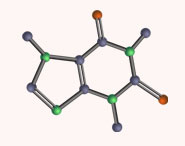


 علم الكيمياء
علم الكيمياء 
 الكيمياء التحليلية
الكيمياء التحليلية 
 الكيمياء الحياتية
الكيمياء الحياتية 
 الكيمياء العضوية
الكيمياء العضوية 
 الكيمياء الفيزيائية
الكيمياء الفيزيائية
 الكيمياء اللاعضوية
الكيمياء اللاعضوية 
 مواضيع اخرى في الكيمياء
مواضيع اخرى في الكيمياء
 الكيمياء الصناعية
الكيمياء الصناعية |
أقرأ أيضاً
التاريخ: 2023-08-17
التاريخ: 18-9-2019
التاريخ: 31-10-2016
التاريخ: 5-8-2018
|
When σ bonds act as nucleophiles, the electrons also have to go to one end of the σ bond as they form a new bond to the electrophile. We can return to an earlier example, the reaction of sodium borohydride (NaBH4) with a carbonyl compound, and complete the mechanism. In this example, one of the atoms (the hydrogen atom) moves away from the rest of the BH4 anion and becomes bonded to the carbonyl compound. The LUMO of the electrophile is, of course, the π* orbital of the C=O double bond.
The arrow from the nucleophile should start in the middle of the bond that breaks and show which atom is transferred to the electrophile. You could use an atom-specifi c arrow if you wanted to make it absolutely clear that the electrons in the σ bond act as a nucleophile through the hydrogen and not through the boron atom:
The anion which forms is an intermediate, not the final product. The reaction is often carried out in water and the anion acts as a nucleophile to remove a proton from water. Water is the electrophile: its LUMO is the O–H σ*.
● Summary: Curly arrow health check
• A curly arrow shows the movement of a pair of electrons.
• The tail of the arrow shows the source of the electron pair, which will be a fi lled orbital (HOMO) and can be represented by:– a lone pair– or a negative charge– or a π bond– or a σ bond.
• The head of the arrow indicates the destination of the electron pair, which will be:
– an empty atomic orbital where a new bond will be formed
– or a π* or σ* antibonding orbital where a new bond will be formed and an old bond will break
– or an electronegative atom that can support a negative charge.
• Overall charge is always conserved in a reaction.



|
|
|
|
حقن الذهب في العين.. تقنية جديدة للحفاظ على البصر ؟!
|
|
|
|
|
|
|
"عراب الذكاء الاصطناعي" يثير القلق برؤيته حول سيطرة التكنولوجيا على البشرية ؟
|
|
|
|
|
|
|
مشاتل الكفيل تنتج أنواعًا مختلفة من النباتات المحلية والمستوردة وتواصل دعمها للمجتمع
|
|
|